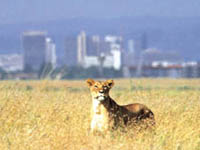Airport
Jomo Kenyatta International Airport
IATA Code: NBOLocation: The airport is situated 10 miles (16km) south east of Nairobi.
Time: GMT +3.
Contacts: Tel: +254 (0)20 822 111
Transfer to the city: The KBS bus service 34 leaves fairly regularly for the city centre; most travellers however take a taxi or arrange to be picked up by their hotel or tour operator. The Mercedes taxis take passengers to the central city hotels for a fixed fare.
Car rental: Avis, Europcar and Hertz, among others, are represented at the airport.
Facilities: The facilities at the airport are fairly limited, but include a bank and bureau de change, left luggage, telephones and fax, medical aid, a bar and restaurant, duty-free shops selling curios, a post office, tourist information and hotel reservations. There are disabled facilities, but passengers should advise their airline in advance of any special needs.
Parking: Short- and long-term parking is available.
Departure tax: US$20, but this is usually included in the ticket price.
Website: www.kenyaairports.co.ke
Visit worldtravels.com for the full guide to Nairobi. Build a complete Nairobi travel guide and email to your clients - sign up for a trial subscription of World Travels Pro.
Nairobi

Nairobi is best characterised by its variety of locally-given descriptive names, representative of the city's contrasting images - of wealthy spacious suburbs, charming flower-lined streets and a refreshing climate, alongside crime, corruption, filth and poverty. Names like 'Green City in the Sun', 'City of Flowers' and the Masai name 'Place of Cool Waters' attempt to overshadow the all too real version of 'Nairobbery' that stands as a well-found warning to newly arrived tourists.
Nairobi is one of Africa's largest and most interesting cities. It is a place of enormous energy, a tireless and thriving bustle of people, and a city of differences. Assorted races, tribes and origins are all a part of its make-up. Rural immigrants and refugees are drawn by the hope of wealth and opportunity, international businessmen are attracted by profitable business prospects, and tourists are promised the makings of the perfect safari. The city centre buzzes with the energy, aspirations and opportunism of moneychangers, safari touts, would-be thieves, food vendors and trinket sellers, prostitutes, shoppers, security guards, and sharp-eyed shoe shiners assessing the footwear of the hurried throngs. Among them are the disillusioned faces of the unemployed, the beggars and the destitute.
Kenyatta Avenue is the city's favourite tourist image, a broad avenue fringed by trees and flowers that was originally designed to allow a twelve-oxen team to make a full turn. There are several museums and places of interest in the centre, including the National Museum and Snake Park. There are numerous markets selling traditional crafts, especially the appealing Masai market. Just outside of the centre is the Nairobi National Park, and the nearby Bomas of Kenya host performances of traditional dancing and singing. The Langata Giraffe Centre offers visitors the chance to hand-feed the Rothschild giraffes that inhabit the area.
Nairobi is also the safari capital of Africa and a good base for travel in Kenya. From here excursions and safaris can be arranged to any of the national parks or reserves in the country.







